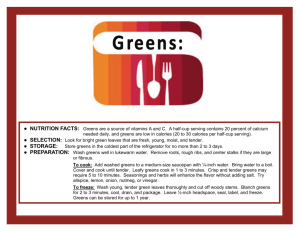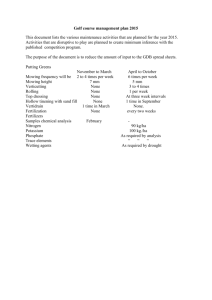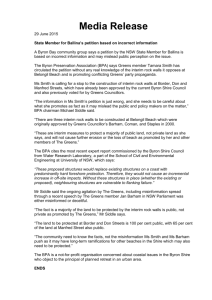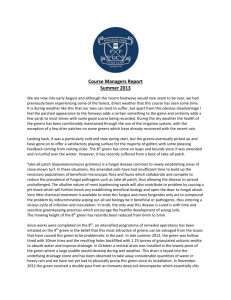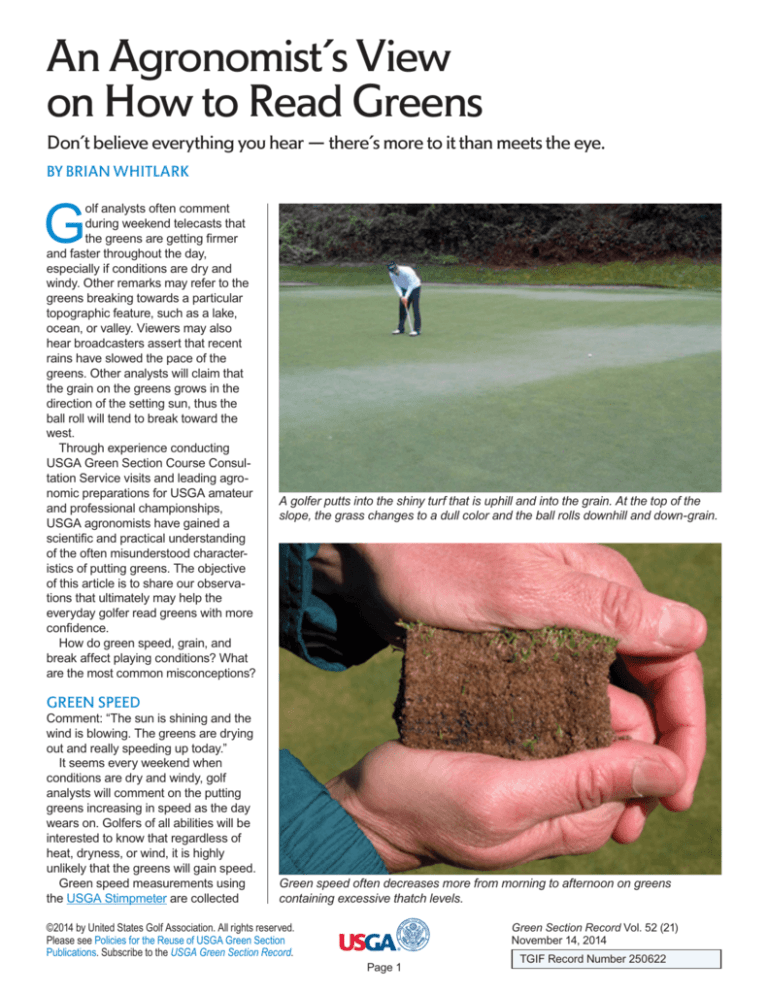
An Agronomist’s View
on How to Read Greens
Don’t believe everything you hear — there’s more to it than meets the eye.
BY BRIAN WHITLARK
G
olf analysts often comment
during weekend telecasts that
the greens are getting firmer
and faster throughout the day,
especially if conditions are dry and
windy. Other remarks may refer to the
greens breaking towards a particular
topographic feature, such as a lake,
ocean, or valley. Viewers may also
hear broadcasters assert that recent
rains have slowed the pace of the
greens. Other analysts will claim that
the grain on the greens grows in the
direction of the setting sun, thus the
ball roll will tend to break toward the
west.
Through experience conducting
USGA Green Section Course Consultation Service visits and leading agronomic preparations for USGA amateur
and professional championships,
USGA agronomists have gained a
scientific and practical understanding
of the often misunderstood characteristics of putting greens. The objective
of this article is to share our observations that ultimately may help the
everyday golfer read greens with more
confidence.
How do green speed, grain, and
break affect playing conditions? What
are the most common misconceptions?
A golfer putts into the shiny turf that is uphill and into the grain. At the top of the
slope, the grass changes to a dull color and the ball rolls downhill and down-grain.
GREEN SPEED
Comment: “The sun is shining and the
wind is blowing. The greens are drying
out and really speeding up today.”
It seems every weekend when
conditions are dry and windy, golf
analysts will comment on the putting
greens increasing in speed as the day
wears on. Golfers of all abilities will be
interested to know that regardless of
heat, dryness, or wind, it is highly
unlikely that the greens will gain speed.
Green speed measurements using
the USGA Stimpmeter are collected
Green speed often decreases more from morning to afternoon on greens
containing excessive thatch levels.
Green Section Record Vol. 52 (21)
November 14, 2014
©2014 by United States Golf Association. All rights reserved.
Please see Policies for the Reuse of USGA Green Section
Publications. Subscribe to the USGA Green Section Record.
Page 1
TGIF Record Number 250622
USGA agronomists measure green speed using the USGA Stimpmeter at least
twice per day during professional and amateur national championships.
at least twice daily on putting greens
leading up to and during USGA championships. The data collected over
hundreds of days and on thousands
of greens shows that green speed
does not increase during the day, but
typically decreases from morning to
afternoon (Championship Green
Speed). Intuitively, one might assume
that as the surface of the green dries,
green speed will increase. However,
as the turf grows, the friction on the
surface of the ball increases and slows
ball roll. To lessen the effect of turf
growth on green speed, turf managers
apply growth regulating compounds.
Although greens treated with growthregulating products lose less speed
when compared to nontreated greens,
speed loss is still inevitable.
Thatch levels can also affect green
speed. Dr. James Beard, a leading
authority on turfgrass science, defines
thatch as “an intermingled organic
layer of dead and living shoots, stems,
and roots of grasses that develops
between the turf canopy of the green
vegetation and the soil surface.”
Typically, the more thatch, the greater
the potential for decreased green
speeds. When thatch is compressed
during morning mowing and rolling
activities, it acts like a sponge and will
decompress or “bounce back” over
several hours. As a result, green
speeds slow down.
If readers are still skeptical about
green speed decreasing throughout
the day, perhaps additional sources
will make you a believer. Paul
Vermeulen, PGA Tour agronomist,
manages numerous PGA Tour,
Champions Tour, and Web.Com tour
events every year. During a recent
phone conversation, Vermeulen
revealed that green speed at PGA
Tour events decreases by about 6
inches on average on a daily basis.
However, there are rare exceptions.
Putting greens on golf courses built before the modern era of course construction tend to slope with the general lay of the land.
Green Section Record Vol. 52 (21)
November 14, 2014
©2014 by United States Golf Association. All rights reserved.
Please see Policies for the Reuse of USGA Green Section
Publications. Subscribe to the USGA Green Section Record.
Page 2
If an area of a green is experiencing
significant wilt, it may not lose speed
or it may gain a marginal amount of
speed during the day. Vermeulen also
noted that when greens approach very
high speeds, e.g., 13 feet as measured
by the USGA Stimpmeter, ball roll will
likely decrease by more than 6 inches
from morning to afternoon. Slower
greens (measuring 9 to 10 feet in the
morning) will likely lose only 3 to 6
inches throughout the day. Essentially,
the faster the green speed, the greater
the potential for speed loss from
morning to afternoon.
University research has confirmed
that green speeds decrease during the
day. A study at Oregon State University
involved 240 Stimpmeter readings per
day, totaling 7,200 measurements per
year. The study concluded that ball-roll
distance decreased an average of 6
inches from morning to afternoon
(Mcdonald, B.W., et al, 2013).
The bottom line is, if you have an
afternoon tee time, you can bet your
two-dollar Nassau that the greens will
be slower than they were for your
fellow golfers playing in the early
morning.
remained at championship levels. Yes,
it is possible to have wet, fast greens
and firm, slow greens.
The bottom line is that you can
expect greens to be softer and more
receptive in the morning following a
heavy irrigation or rain event, but they
won’t necessarily be slower. In fact, the
greens may be faster following a heavy
irrigation or rain event depending on
the morning maintenance routine.
GRAIN
Comment: “This putt is directly into
the setting sun so although the putt is
Greens built
within the last
half century
may not
necessarily
slope toward
a particular
topographic
feature like a
lake, valley, or
ocean. On
modern greens
the ball will
break where
surface water
drains from the
putting surface.
Steve Isaac, director of golf course
management for the R&A, manages
agronomic preparations at the British
Open Championship. He has observed
that green speed most often begins to
decrease after the morning mowing
or rolling and continues decreasing
into the afternoon. However, he did
mention the odd incidence of green
speed increasing in situations of low
fertility, golfer traffic, and dry, windy
conditions. He acknowledged that this
phenomenon may be unique to the
links environment.
FIRMNESS VERSUS SPEED
Comment: “The firmer the surface, the
faster the green speed.”
Intuitively, one would think that
putting green speed of dry, firm greens
would be faster than the speed of wet,
soft greens. However, experience from
working USGA Championships and
communication with USGA and PGA
Tour agronomists confirm that soil
moisture has a negligible effect on
green speed. For example, rainsaturated Merion Golf Club during the
2013 U.S. Open, but green speeds
uphill a touch, it will be faster because
it is down grain.”
Grain in putting greens can be
described as the horizontal orientation
of turfgrass leaves and stems. Bermudagrass and bentgrass species, especially
older varieties of bentgrass, exhibit
grain while Poa annua has very little
grain, if any. Turf managers employ a
variety of techniques like grooming,
brushing, and vertical mowing to
encourage upright turf growth and
minimize grain. Furthermore, when
turfgrasses are mown at 1/8 inch or
Green Section Record Vol. 52 (21)
November 14, 2014
©2014 by United States Golf Association. All rights reserved.
Please see Policies for the Reuse of USGA Green Section
Publications. Subscribe to the USGA Green Section Record.
Page 3
less, any effect of horizontal leaf
orientation on ball roll is minor.
Which direction does grain grow? Is
it toward the east in the early morning
and then west in the afternoon? Does
it grow toward the ocean or a nearby
lake or valley? No, grain grows downhill. This is due to various factors.
Grain follows the direction of surface
water. Additionally, regardless of the
mowing direction, the roller and the
drum on a mower will flatten the turf
in the direction of the slope. Like all
plants, turfgrass exhibits phototropism,
which is the orientation of a plant or
other organism in response to light.
However, when maintained at less
than 1/8 inch, turf leaves and stems do
not change their orientation in relationship to a light source (personal communication, Dr. Bingru Huang, Rutgers
University, Department of Plant Biology
and Pathology, specialist in turfgrass
physiology).
The bottom line is that grain on
bentgrass and bermudagrass putting
greens has a minimal effect on ball roll,
and when grain is present it grows
downhill.
THE INFLUENCE OF
LOCAL TOPOGRAPHIC
FEATURES ON BREAK
Comment: “The players need to keep
in mind this weekend that the natural
tendency of the ball is to break toward
the ocean.”
On any green, the ball will break
where water flows — i.e., downhill.
Greens that were built more than 50
years ago without large earthmoving
construction equipment will tend to
slope with the general lay of the land.
However, the slope on more recently
built greens may not cant toward any
specific topographical feature. In fact,
many greens are pitched away from
Green speeds remained at championship levels despite torrential rains soaking
the greens during the 2013 U.S. Open at Merion Golf Club.
streams, lakes, or wetlands to avoid
runoff and to protect the environmental
integrity of golf course ecosystems.
The bottom line is that on most
courses, there is no “general” tendency
for the ball to break toward a valley,
stream, lake, or ocean. The ball will
break downhill where water drains
from the green, which may be several
locations on a green depending on the
design.
CONCLUSION
During your next round of golf, remember that when playing in the afternoon
the greens likely will be slower than
they were in the morning. The grain, if
any, will have minimal impact on ball
roll, but if it does, the grain will accentuate the roll in the downhill direction.
In addition, be skeptical of the notion
that the greens will have a tendency to
break “away from the mountains” or
“toward the Salton Sea.” The ball will
simply roll down slope, which more
than likely is exactly how the architect
designed and built the greens.
REFERENCE
McDonald, B. W.; Golembiewski, R.
C.; Cook, T. W.; and Blankenship, T. M.
(2013). Effects of Mowing and Rolling
Frequency, Primo Maxx, and Roller
Weight on Annual Bluegrass Putting
Green Speed. Online. Applied
Turfgrass Science doi:10.1094/
ATS-2013-0529-01
BRIAN WHITLARK is an agronomist
in the Southwest Region.
Green Section Record Vol. 52 (21)
November 14, 2014
©2014 by United States Golf Association. All rights reserved.
Please see Policies for the Reuse of USGA Green Section
Publications. Subscribe to the USGA Green Section Record.
Page 4

